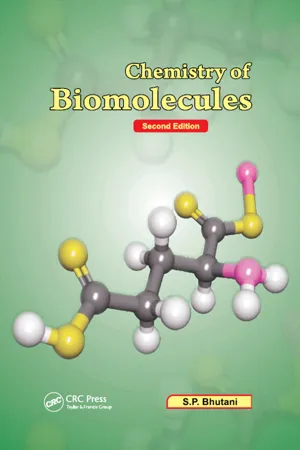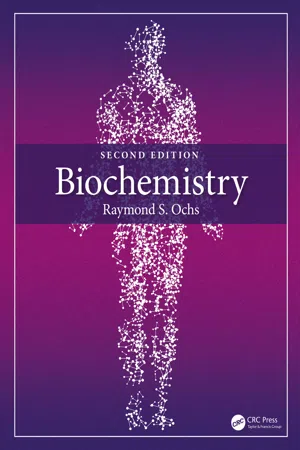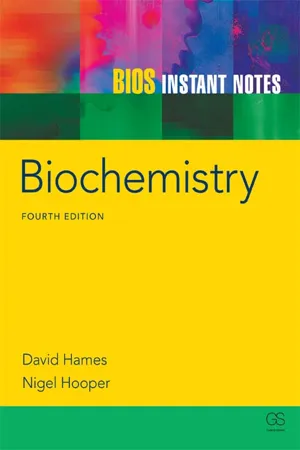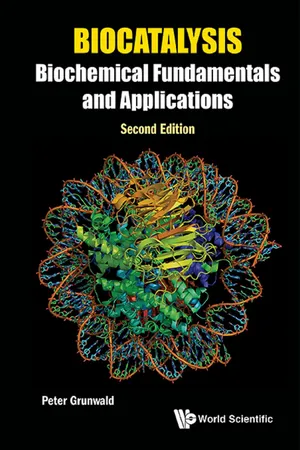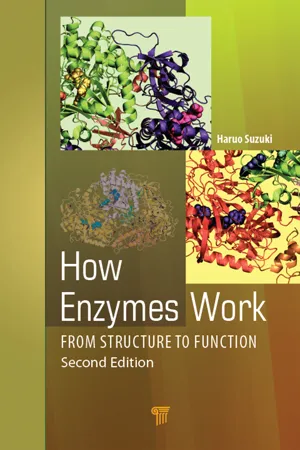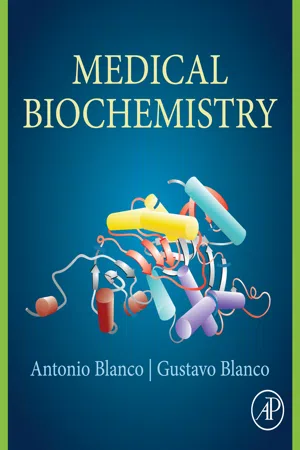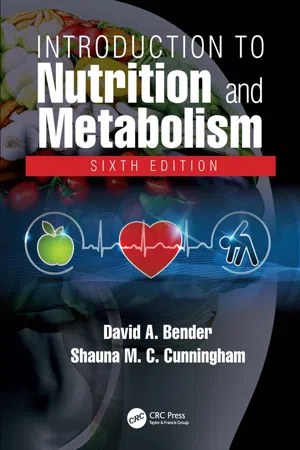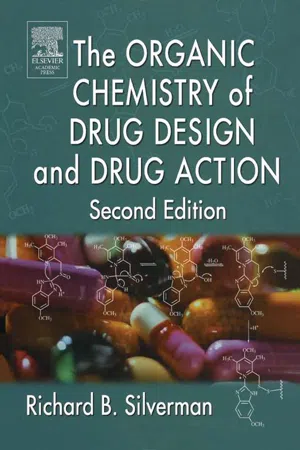Chemistry
Enzyme Cofactor
An enzyme cofactor is a non-protein chemical compound that is required for enzyme activity. It can be either inorganic (such as metal ions) or organic (such as coenzymes). Cofactors assist enzymes in catalyzing chemical reactions by providing functional groups or aiding in electron transfer.
Written by Perlego with AI-assistance
Related key terms
Related key terms
1 of 4
Related key terms
1 of 3
11 Key excerpts on "Enzyme Cofactor"
- eBook - ePub
- S. P. Bhutani(Author)
- 2019(Publication Date)
- CRC Press(Publisher)
Some enzymes in order to exhibit catalytic reactivity require additional chemical compounds called cofactors. Cofactors are molecules that attach to an enzyme during chemical reactions. In general, all compounds that help enzymes in their catalytic reactivity are called cofactors. A cofactor is any non-protein component in an enzyme. It is an organic molecule or metal ion which the enzyme requires in order to catalyse a reaction.We have seen that most enzymes are simple globular proteins. Some others are conjugated proteins which have a non-protein fraction called the prosthetic group. A prosthetic group is an essential cofactor attached to the protein part of a conjugated enzyme. That means cofactors which are bound tightly to an enzyme are termed as prosthetic groups. These can be organic vitamins, sugars, lipids etc.An enzyme without a cofactor is called an apoenzyme and the enzyme-cofactor complex is called a holoenzyme. Apoenzyme is enzymatically an inactive protein. Cofactors can be divided into two groups.• Organic cofactors, which are called coenzymes. • Inorganic cofactors – essential metal ions.Organic cofactors are known as coenzymes. A coenzyme is an organic non-protein compound that binds with an enzyme to catalyse a reaction.B. Coenzymes
A coenzyme cannot function alone but can be reused several times when paired with an enzyme. Coenzymes are heat stable, low molecular weight organic compounds required for the activity of enzymes. Coenzymes act as group transfer reagents. These are reusable non-protein molecules that contain carbon. They bind loosely to an enzyme at the active site to help catalyse reactions. They are linked to enzymes by non-covalent forces. Most coenzymes are vitamins, vitamins derivatives or derived from nucleotides.C. Cofactors
Unlike coenzymes true cofactors are reusable non-protein molecules that do not contain carbon i.e - eBook - ePub
- Raymond S. Ochs(Author)
- 2021(Publication Date)
- CRC Press(Publisher)
7 CoenzymesA coenzyme is a small molecule that associates with an enzyme, expanding its chemical repertoire. By small, we mean a molecule with no higher-order structure (i.e., unlike a protein or polysaccharide polymer); typically, coenzymes have a molecular weight on the order of 1000. The need for more elaborate chemistry in enzyme catalysis will become clear as we explore the commonly encountered coenzymes.Many enzymes can catalyze reactions exclusively using their aminoacyl functional groups, such as acetylcholine esterase in the previous chapter. Aside from new chemical possibilities, there is a second reason enzymes utilize coenzymes. In some cases, electrons or a phosphoryl group must be transferred between enzymes within a cell space. We call such carriers mobile coenzymes.7.1 Coenzymes: Bound and Mobile
We can divide coenzymes into two types: bound (prosthetic groups), and mobile. Bound coenzymes function as part of the enzyme itself, attached by covalent bonds or strong non-covalent forces so that they are not detached from the enzyme over many catalytic cycles. While a bound coenzyme can undergo chemical change within an enzymatic cycle, it must regain its original chemical form at the end of the reaction, just as the rest of the enzyme does. Mobile coenzymes (or mobile cofactors) do not regain their original chemical form at the end of the reaction. From the standpoint of an individual reaction, a mobile cofactor is indistinguishable from a substrate or product. To underscore this point, they are also known as cosubstrates and coproducts. Separate enzymatic reactions must regenerate the original form of mobile cofactors.We have already encountered a prosthetic group: the heme of myoglobin and hemoglobin (Chapter 5 - eBook - ePub
- David Hames, Nigel Hooper(Authors)
- 2011(Publication Date)
- Taylor & Francis(Publisher)
If neither the substrates nor products of an enzyme-catalyzed reaction absorb light at an appropriate wavelength, the enzyme can be assayed by linking it to another enzyme-catalyzed reaction that does involve a change in absorbance. The second enzyme must be in excess, so that the rate-limiting step in the linked assay is the action of the first enzyme.Coenzymes and prosthetic groupsSome enzymes require the presence of cofactors, small nonprotein units, to function. Cofactors may be inorganic ions or complex organic molecules called coenzymes. A cofactor that is covalently attached to the enzyme is called a prosthetic group. A holoenzyme is the catalytically active form of the enzyme with its cofactor, whereas an apoenzyme is the protein part on its own. Many coenzymes are derived from dietary vitamin precursors, and deficiencies in them lead to certain diseases.IsozymesIsozymes are different forms of an enzyme, which catalyze the same reaction, but which exhibit different physical or kinetic properties. The isozymes of lactate dehydrogenase (LDH) can be separated electrophoretically and can be used clinically to diagnose a myocardial infarction.Related topics(A4 ) Cell imaging(B2 ) Protein structure and function(D2 ) Thermodynamics(D3 ) Enzyme kinetics(D4 ) Enzyme inhibition(D5 ) Regulation of enzyme activityEnzymes as catalysts
Enzymes are catalysts that increase the rate of a chemical reaction without being changed themselves in the process. In the absence of an enzyme, the reaction may hardly proceed at all, whereas in its presence the rate can be increased up to 1017 -fold. Enzyme-catalyzed reactions usually take place under relatively mild conditions (temperatures well below 100°C, atmospheric pressure and neutral pH) as compared with the corresponding chemical reactions. Enzymes are also highly specific with respect to the substrates on which they act and the products that they form. In addition, enzyme activity can be regulated, varying in response to the concentration of substrates or other molecules (Section D5). Nearly all enzymes are proteins, although a few catalytically active RNA molecules (ribozymes - eBook - ePub
- Stefan Lutz, Uwe Theo Bornscheuer(Authors)
- 2012(Publication Date)
- Wiley-VCH(Publisher)
8 Enzyme Engineering by Cofactor Redesign Malgorzata M. Kopacz, Frank. Hollmann, and Marco W. Fraaije8.1 Introduction
Enzymes catalyze a wide range of chemical reactions in nature, for which helper molecules – cofactors – are often employed. Cofactors are non-protein small molecules or atoms that are required in the active site of enzymes and are directly involved in catalysis. Cofactors thus extend the scope of chemistry in nature beyond what is feasible when using only amino acids. Although more than half of all known enzymes use such “helper molecules” [1], the actual number of natural cofactors is, nevertheless, limited. In order to broaden the catalytic potential of enzymes, recent protein engineering approaches have been expanded to develop, and subsequently employ, enzymes containing redesigned cofactors.It is assumed that many natural organic cofactors have evolved from ribozymes, which are catalytic RNA molecules. The discovery of RNA-based catalysis brought an end to the idea that enzymes are the only natural catalytic machineries, and placed RNA before DNA and proteins in the evolution of life [2, 3]. It is hypothesized that around four billion years ago, in the so-called “RNA world,” a collection of RNAs or RNA-like molecules could function as a carrier of genetic information and as a catalyst of essential chemical reactions [4–6]. It is interesting to note that some of the most common contemporary Enzyme Cofactors, such as nicotinamide adenine dinucleotide (NAD) and flavin adenine dinucleotide (FAD), are derivatives of ribonucleotides. Furthermore, it has been found that several of the most ubiquitous cofactors can be targets for riboswitches [7–17], which are functional RNA molecules able to directly sense and regulate levels of cellular metabolites [18]. Therefore, it is speculated that cofactors were actually first utilized by ribozymes. For example, it has been proposed that NAD+ and NADP+ - eBook - ePub
Biocatalysis
Biochemical Fundamentals and Applications
- Peter Grunwald(Author)
- 2017(Publication Date)
- WSPC (EUROPE)(Publisher)
Chapter 4Non-protein Groups in Biocatalysis
Frequently, enzymes develop their catalytic activity solely on the basis of a specific arrangement of some few amino acid residues. However, there are many others — about half of all known enzymes or even more — that need the assistance of cofactors of organic or inorganic origin which are metal ions in the latter case or small organic molecules, constituting a group of metabolites that after use in a biotransformation are regenerated. An impressive example is the ‘universal energy carrier’ adenosine triphosphate (ATP + H2 O → ADP + Pi + H+ ; ΔG pH=7 : ˗30.5 kJ/mol) present, e.g., in the human body in some few grams; however the amount of ATP regenerated per day from ADP and inorganic phosphate (Pi ) in the mitochondria approximately equals the body weight (Törnroth-Horsefield and Neutze, 2008). Orth et al. (2011) updated the genome-scale metabolic network reconstruction of E. coli and found ATP to be the most commonly used cofactor participating in 359 reactions, followed by ADP, NAD, NADH, NADP, NADPH and others (see also Meyer et al., 2014).A metal ion or another non-protein group that is bound covalently to an enzyme’s active site is termed prostetic group. These are usually distinguished from so-called coenzymes that are organic molecules of low molecular weight — a differentiation not always kept consequently in the relevant literature. Many coenzymes are in dissociation/association equilibrium with the catalysts and are modified during the reaction so that they rather have the function of a co-substrate; examples are NAD+ and NADH (the oxidized and the reduced form of nicotinamide adenine dinucleotide) that transfer hydride (H− ) ions. However, other coenzymes as the electron transferring cofactors FAD (flavin adenine dinucleotide) and FMN (flavin mononucleotide) are bound to the respective enzyme rather tightly — sometimes even covalently as in case of the flavoprotein succinate dehydrogenase (EC 1.3.99.1), an enzyme complex that in a first step oxidizes succinate to fumarate with FAD as oxidant. Coenzymes in addition may contain a metal ion (Czerniecki and Czygier, 2001) that is coordinated by electron pair donating atoms; in some rare cases real metalorganic Mz+ –carbon bonds are formed. An active enzyme together with its essential metal ion and/or coenzyme is named holoenzyme, and the protein portion apoenzyme. The following table provides an overview of the distribution of metal ions among the different enzyme classes (Andreini et al., 2008; more information about mechanisms of metalloenzymes are available from the Metal-MACiE database: http://www.ebi.ac.uk/thornton-srv/databases/Metal_MACiE/home.html - eBook - ePub
- Reinhard Renneberg, Vanya Loroch(Authors)
- 2016(Publication Date)
- Academic Press(Publisher)
Fig. 2.10 )—which are hydrophobic (literally: afraid of water) turn inward to avoid contact with water. They hold the molecule together in much the same way as drops of oil stabilize in water.Apart from the interaction between side groups, loose hydrogen bonds develop between neighboring oxygen and hydrogen atoms in the backbone of the various amino acids.Jöns Jacob Berzelius (1836)“The catalytic force actually appears to consist in the ability of substances to arouse the affinities dormant…by their mere presence and not by their affinity and so as a result in a compound substance the elements become arranged in another way—such that a greater electrochemical neutralization is brought about.”2.3 The Role of Cofactors in Complex Enzymes
Not all enzymes consist exclusively of protein, as does lysozyme. Many include additional chemical components or cofactors which serve as tools. Such enzymes are known as qualified enzymes and have more complicated reaction mechanisms.Cofactors can consist of one or more inorganic ions (such as Fe3+ , Mg2+ , Mn2+ , or Zn2+ ) or more complex organic molecules, known as coenzymes . Some enzymes require both types of cofactors.Coenzymes are organic compounds that bind to the active site of enzymes or near it. They modify the structure of the substrate or move electrons, protons, and chemical groups back and forth between enzyme and substrate, negotiating considerable distances within the giant enzyme molecule. When used up, they separate from the molecule.Many coenzymes are derived from vitamin precursors , which explains why we require a constant low-level supply of certain vitamins. One of the most essential coenzymes, NAD+ (nicotinamide adenine dinucleotide - eBook - ePub
How Enzymes Work
From Structure to Function
- Haruo Suzuki(Author)
- 2019(Publication Date)
- Jenny Stanford Publishing(Publisher)
Chapter 7Cofactors
Chapter 6 described the structure of protein. This chapter describes the regions related to the protein function. The first half of the chapter deals with familiar cofactors in the biochemistry textbook. The rest deals with cofactors formed via post-translational modification of enzyme active site. These cofactors may be unfamiliar to the reader, but widen the enzyme function. There are many cofactors, but I could not cover the whole here, since to include all the cofactors is beyond the scope of this book. Let’s start with some definition.7.1 Active Site and Active Center
In the previous chapters, the term active site was used without definition. The active site means the region (area or place) of enzyme protein where substrate binds and is transformed to product. For the same meaning, the active center has been used. The “center” means “point.” However, accumulation of 3D structures of enzyme has shown that the region of enzyme related to the function is broad in space. Therefore, it seems better to use the term “active site.”7.2 Cofactor, Coenzyme, Prosthetic Group
The active site of enzyme is usually composed of several amino acid residues. However, various enzymes also require metal ions, and/or organic groups for the activities. The terms used to denote these groups seem to be slightly different from one book to another. Here, the following usage is applied in this book. A cofactor means substances required for the activity of enzyme. The cofactor includes metal ions, coenzyme, and prosthetic groups [1 ].Coenzyme binds with the enzyme protein reversibly, and acts like substrate. Prosthetic group is an organic compound, binds strongly with enzyme, and is usually present as a protein-bound form. The cofactor-bound enzyme (protein) is called holoenzyme (holoprotein), and the cofactor-unbound enzyme (protein) is apoenzyme (apoprotein). Table 7.1 - eBook - ePub
Biomass, Biofuels, Biochemicals
Advances in Enzyme Catalysis and Technologies
- Sudhir P. Singh, Ashok Pandey, Reeta Rani Singhania, Christian Larroche, Zhi Li(Authors)
- 2020(Publication Date)
- Elsevier(Publisher)
[10] . The charged and/or polar residues participate in charge stabilization and exchange of electrons and protons. The catalytic residues are conserved and have structural rigidity over other residues in the enzyme. Such features make an enzyme, specific toward the substrate.1.2.2 Cofactor, a necessity of enzyme
Another vital aspect of the enzyme, which distinguishes it from protein, is the requirement of a non-protein substance called as cofactors, the essential component for execution of catalytic reaction. Cofactors can further be categorized into prosthetic groups and coenzymes, depending on their type of association with the enzymes [5] . Prosthetic groups are a small molecule, which remains bound to the enzyme; for example, heme is bound to myoglobin and hemoglobin protein as an essential component for oxygen binding. In some cases, metal ions (such as zinc or iron) remain bound to the enzymes, playing a critical role in the catalysis. Coenzymes carry chemical groups; for example, nicotinamide adenine dinucleotide (NAD+ ) functions as an electron carrier in oxidation–reduction reactions [9] . Interestingly, the presence of cofactor can induce conformational changes in the enzyme that may increase the fitting and interaction of the substrate with the active site [11] .1.3 What is enzyme catalysis?
1.3.1 Basics of enzyme catalysis
Enzyme catalysis plays a vital role in the metabolism of all the living organisms. Enzymatic reactions are like chemical reactions, which result in the product, and the free energy change (ΔG ) during this process is negative. However, the rate of reaction depends on another factor, known as activation energy (EA). If the ΔG is favorable, but still the need of high EA leads to slower progression of the reaction. The biological reaction is required to be catalyzed in the fractions of a second [12] . The slower biochemical changes are made faster (1010 –1020 ) by using the enzymatic actions, without which a reaction may take millions of years to complete [13] - eBook - ePub
- Antonio Blanco, Gustavo Blanco(Authors)
- 2017(Publication Date)
- Academic Press(Publisher)
ribozymes (p. 501).Current techniques have allowed us to understand the exact structure and build accurate models of many enzymes. This has shed light on the mechanism of enzyme action. Some enzymes are composed by only amino acids. Hydrolases, in general, are simple proteins. Other enzymes are formed by the association of various subunits or polypeptide chains, constituting oligomers. Often, the association between the subunits that form an enzyme is of functional significance.Coenzyme . Many enzymes only perform their catalytic role when associated with another nonprotein molecule, of relatively small size, called a coenzyme . Coenzymes can be firmly attached to the enzyme by covalent or other strong bonds, forming complexes that are difficult to separate. Some authors prefer to call them prosthetic groups and reserve the name coenzyme for those chemical groups that are more loosely associated to the protein. In this textbook, the name coenzyme will be used indistinctly. Both the protein and nonprotein portions are essential for enzyme activity. The entire system is called holoenzyme and consists of the protein or apoenzyme (a macromolecule, thermolabile and nondialyzable) and the coenzyme (nonprotein molecule, thermostable and of relatively small size).Oxidoreductases, transferases, isomerases, and ligases require coenzymes. These are actively involved in the reaction, undergoing changes that compensate for the transformation undergone by the substrate. For example, the coenzymes in oxidoreductases accept or transfer the hydrogens or electrons subtracted from or donated to the substrate. Transferases have coenzymes, which accept or donate the group transferred in the reaction.Many coenzymes present structures that resemble nucleotides. Moreover, coenzymes are related to vitamins , compounds that the body cannot synthesize and must be supplied with the diet. B complex vitamins function as coenzymes themselves or form part of the structure of coenzymes. This participation in enzymatic processes gives many vitamins their physiological importance. Table 8.1 lists different coenzymes and the vitamin they are related to. The functional role of vitamins will be described in Chapter 27 - eBook - ePub
- David A Bender, Shauna M C Cunningham(Authors)
- 2021(Publication Date)
- CRC Press(Publisher)
in vitro without added coenzyme permits measurement of what was initially present as holoenzyme, while incubation with substrate after the addition of coenzyme permits activation (and hence measurement) of the apoenzyme. The increase in catalytic activity after addition of coenzyme is the activation coefficient; for someone whose vitamin status is good, the activation coefficient will be only slightly greater than 1.0; the higher the activation coefficient (meaning that there is more apoenzyme without its coenzyme), the poorer the subject’s vitamin status.Key Points
• Breaking of covalent bonds requires an input of energy (the activation energy) to excite electrons to an unstable configuration.• Exothermic reactions proceed with output of heat, and endothermic reactions require an input of energy.• Enzymes catalyze reactions by lowering the activation energy; they increase the rate at which equilibrium is reached but do not affect the position of equilibrium. In vivo reactions are not normally at equilibrium because there is constant flux through the pathway.• The active site of an enzyme comprises a substrate-binding site and a catalytic site; both are formed by reactive groups in the side chains of amino acids that may be some distance apart in the primary sequence of the protein.• Enzymes show considerable specificity for the substrates bound and the reaction catalyzed.• Enzymes may have nonprotein components, coenzymes or prosthetic groups that may be covalently or noncovalently bound to the protein and are essential for activity.• Most enzymes show a hyperbolic relationship between the concentration of substrate and the rate of reaction; V max is the maximum rate of reaction when the enzyme is saturated with substrate.• K m is an inverse measure of the affinity of an enzyme for its substrate; it is the concentration of substrate at which the enzyme achieves half V max .• - Richard B. Silverman(Author)
- 2012(Publication Date)
- Academic Press(Publisher)
Chapter 4 Enzymes Publisher Summary This chapter discusses the role of enzymes as catalysts, mechanisms of enzyme catalysis, coenzyme catalysis, and enzyme therapy. Enzymes are natural proteins that catalyze chemical reactions. Most enzymes are soluble and found in the cytosol of cells. They interact with substrates to form enzyme–substrate complexes, thereby transforming the substrates into products. Enzymes function by lowering transition state energies and energetic intermediates and by raising the ground state energy. The transition state for an enzyme-catalyzed reaction is a high-energy state with a lifetime of about 10 -13 sec, the time for one bond vibration. Once the substrate binds to the active site of the enzyme, there are a variety of mechanisms that the enzyme can utilize to catalyze the conversion of the substrate to product. Some enzymes are useful as drugs, and such enzymes have therapeutic utility to catalyze hydrolytic reactions. The use of genetic engineering techniques to produce altered active enzymes has enhanced the use of enzymes as drugs
Index pages curate the most relevant extracts from our library of academic textbooks. They’ve been created using an in-house natural language model (NLM), each adding context and meaning to key research topics.
Explore more topic indexes
Explore more topic indexes
1 of 6
Explore more topic indexes
1 of 4
